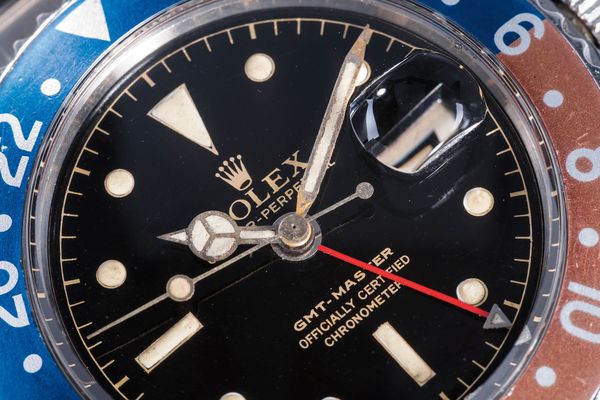- By Geoff Hess
The collecting gene is complex and we all have our own unique recipe of tastes and styles that we prefer. In the context of wristwatches, how then do we delineate what’s really “iconic” within our great hobby? It occurred to me that maybe a simple exercise of word association could provide some helpful insight.
Word association is defined as a method in psychoanalysis where a person says the first word they think of when a particular word is said…and from that we can discover patterns and preferences within our mind. So I approached a few collector friends with the following word association game, and interestingly, they each gave largely the same answer:
When you hear the words “dive watch” what comes to mind?
The answer: The Submariner.
When you hear the words “travel watch” what comes to mind?
The answer: The GMT-Master.
When you hear the words “explorer watch” what comes to mind?
The answer: The Rolex Explorer.
It’s clear that these are models that nearly all of us respect, and that many of us passionately collect. They’re indelible fixtures in the world of vintage watches, and they’ve never been more popular or appreciated than today. When I asked the same few collectors why they were attracted to these groups of watches, their answers were uniquely varied and complex.
But there was one common aspect in which each shared a fondness - and that was the dial.
With a production run of over 60 years, the Submariner, the GMT-Master and the Explorer employ literally dozens of dial configurations with different designs, textures, fonts and even chemical compositions. This makes sense of course, as after all, a dial is the face of a watch. It occupies the vast majority of what our eyes see when we look at our watches to tell the time.
So without getting too technical, I examined an important category of dials that brings our three reference groups together: the unquestionably iconic “gilt/gloss” dials produced by Rolex from the mid 1950s until approximately 1967.
Most commonly, the term “gilt” refers to the gold tone of the text and other printing seen on these dial types…and the term “gloss” refers to the mirror-like, glossy appearance of its surface.
For this group of collectors, along with myself and many others, the sheer beauty of a well-preserved glit/gloss dial is absolutely mesmerizing. Their mirrored surfaces reflect light with amazing vibrancy, alongside the dazzling of the gilt printing, making the dials come to life. Under different lighting conditions, the effect is almost magical. With their very limited production run – just 15 short years – and the difficulty in finding well-preserved examples, it’s no wonder Rolex watches fitted with these gilt/gloss dials are amongst the most sought after of all vintage Rolex models.
These stunning gilt/gloss Rolex dials, in fact, resulted from a highly skilled technical production process known as galvanization. At a time when many watch manufacturers would simply paint text on the surface of a dial, in the 1950s-60s Rolex did not.
A polished brass dial plate was gold plated, and text and minute tracks were first stenciled out atop its surface by applying a protective coating. The full dial was then dipped in a black, paint-like liquid, which would not adhere to the stenciled and protected text and minute track. Thereafter, a final application of a clear lacquer was placed over the painted dial and print.
The end result was that the stunning gold-colored text of the dial was actually the gold-plated brass plate underneath peering through the gloss. Accordingly, in gilt/gloss dials we see a recessed edge to the gilt lettering which provides a subtle but important depth to the print.
Finally, additional printing (such as a depth rating appearing in a silver color, versus gold) was oftentimes applied later, over the lacquer coating, followed by luminous hour markers.
A meaningful part of the collectability of vintage Rolex sports models from this era lies in the fact that virtually every gilt/gloss dial has its own uniqueness…its own character in the way it aged and developed patina…so that no two dials are truly identical.
Much like our own faces, over time these dials sometimes developed lines (which were cracks in the lacquer), a variety of age spots, or different shades of coloring of the text which can vary from muted yellow to rich copper gold as the protective lacquer aged over the decades. As many collectors know, even the dial surface can gradually turn from black to brown, a characteristic known amongst enthusiasts as turning “tropical”, some even developing a coveted, light “caramel” shade.
Many of these wonderful aging effects can be attributed to the composition of the luminous material used on the dial, which varied in substance from the 1950s through today. The luminous material, as well as the chemicals used for the paint and lacquer, could have a material impact on the long-term condition of these dials and their ultimate appearance.
In sunlight and under magnification, the secrets of each dial are revealed.
The earliest gilt/gloss dials from the Submariner, GMT-Master, and Explorer had a gold connected minute track along their outer circumference, known as the “chapter ring”, and were collectively produced until approximately 1963-64, with most manufactured between 1953 through 1962. The chapter ring was purely a design element that added a beautiful continuity to the dial canvas.
Thereafter, production of these gilt/gloss dials continued without chapter rings until 1967 (from 1963-67).
With that said, “a picture is worth a thousand words”, so I took a look at three gilt/gloss vintage reference groups, each sought-after cornerstones in the world of watch collecting: The Explorer reference 1016, the GMT-Master reference 1675, and the Submariner references 5512 and 5513.
The Explorer reference 1016:
The ref. 1016 was introduced in 1959 and its gilt/gloss dial was made by the Jean Singer & Cie dial manufacturing company.
The first version from 1959 and 1960 used the “Officially Certified Chronometer”, or “OCC”, designation on the dial at 6 o’clock, carried over from the earlier Explorer reference 6610 of the late 1950s indicating the use of a chronometer-certified movement.
Dials with chapter rings appeared in the initial run of the 1016. One interesting design detail with chapter ring 1016s is that the luminous hour markers are actually recessed and appear “pressed” into the dial. The concurrent 5512, 5513 and 1675 references did not share this unique trait.
These early dials were manufactures prior to the use of tritium for the luminous hour markers and hands, and were marked solely “Swiss” at 6 o’clock.
Example 1 - Rolex, Ref. 1016 sold during GAME CHANGERS
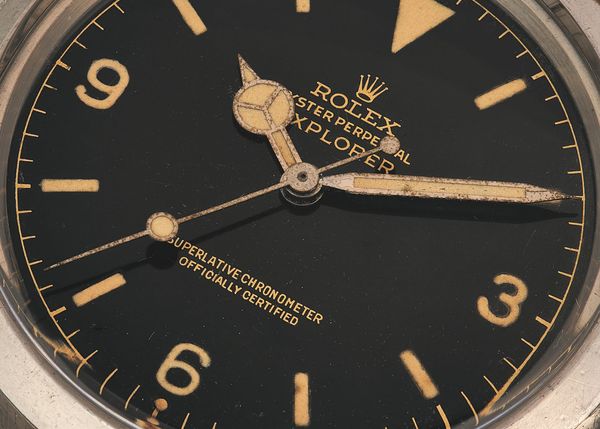
The simpler “OCC” designation was quickly phased-out, with most reference 1016s having “Superlative Chronometer Officially Certified” (“SCOC”)-marked dials.
In approximately 1962 to 1963, Rolex abandoned the use of a chapter ring for the minute track across their sports models. The individual minute markers would now reside at the outer edge of the dial’s circumference for improved legibility, it’s believed. Most non-chapter ring 1016 dials were produced with a thicker lacquer, and as a result, had a greater “mirror gloss” appearance than their chapter-ring predecessors.
As with all Rolex gilt/gloss dials, we see a depth to the edge of the gilt lettering where the underlying brass dial plate was exposed.
Example 2 - Rolex, Ref. 1016 sold during WINNING ICONS
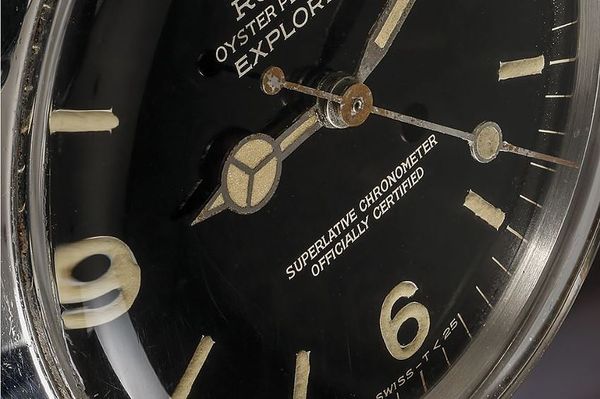
The GMT-Master reference 1675:
Like the 1016, the GMT-Master reference 1675 was also introduced in 1959 and its gilt/gloss dial was similarly made by Singer. Now incorporating a metal bezel insert replacing the fragile Bakelite bezel insert of the original GMT-Master reference 6542 produced from 1954, the earliest 1675s from 1959 and 1960 had the “OCC” indication on the dial, carried over from the 6542.
The chapter ring dials appeared in examples produced until 1962 and were fabricated using a luminous composition that pre-dated the use of tritium and were marked with the “Swiss”-only designation at 6 o’clock.
Examples 3 and 4, Rolex - Ref. 1675 from the 1960s, sold during the GWA5 and the GWA9
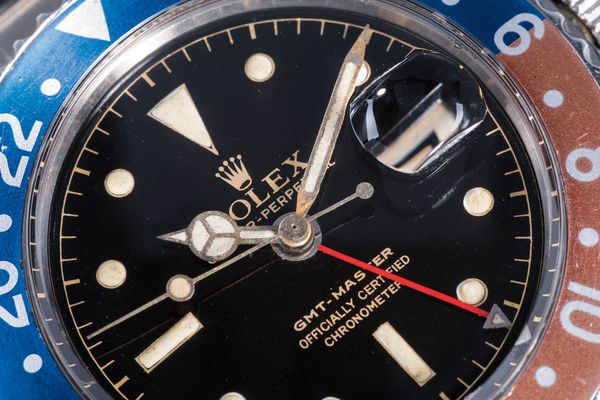
As seen with the reference 1016, the later, non-chapter ring 1675 dials produced beginning around 1963 typically had a thicker lacquer coating and a magnified “glossy mirror” appearance.
As a result, we can often see the texture of the underlying gold-plated brass dial more readily on the earlier chapter ring 1675 gilt dials.
In some examples with or without chapter ring we may also see a small, printed underline either above or below the center of the dial, a transitional designation indicating the use of tritium for the luminous hour markers. The underline would be replaced by the standard “SWISS T<25” designation at 6 o’clock beginning in approximately 1964.
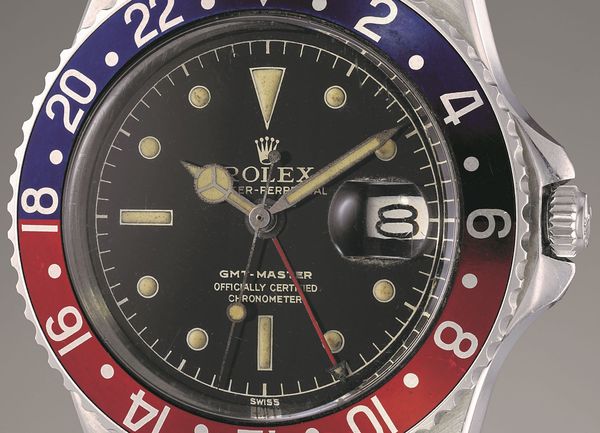
Similarly, in rarer instances the “SWISS” or “SWISS T<25” designation at 6 o’clock might be printed twice, a highly sought-after dial configuration known as “Double Swiss”.
Example 5 and 6 - Rolex, Ref. 1675 sold during ROLEX MILESTONES and STYLED
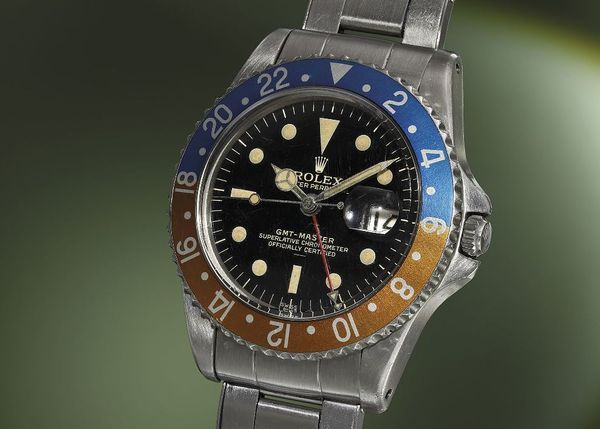
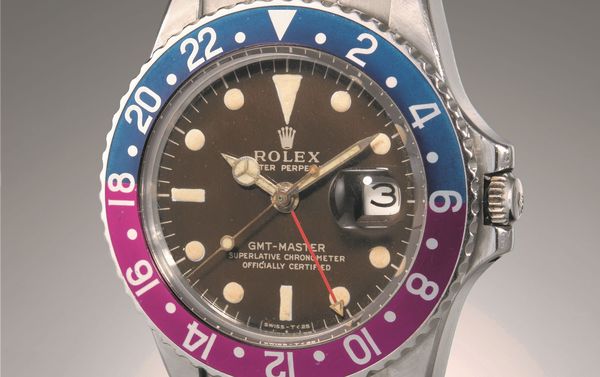
The Rolex Submariner reference 5512 (and 5513):
The first Submariner with a crown guard, the chronometer-certified reference 5512 was produced from 1959 through 1978, and the sister Submariner reference 5513 – using non- chronometer movements - from 1962 through 1990.
Like its 1016 and 1675 sport model cousins, the earliest versions of the reference 5512 used chapter ring dials through 1962 and were manufactured with two configurations: a two-line version with both a depth rating and the word “Submariner”, and a highly sought-after “four-line” variant, which added either the initial OCC or later SCOC certified movement designations.
In addition, different combinations of gold and silver text appeared within this timeframe. Silver print was applied on top of the dial’s clear lacquer, and gold gilt text revealed a hint of the underlying brass plate.
And like the 1016 and 1675, the chapter ring dials of the 5512 appeared until approximately 1962, with a “Swiss” only designation found at 6 o’clock – prior to the use of tritium for the luminous hour markers and hands.
Examples 7, 8, 9 and 10 - Rolex, Ref. 5512 sold during the GWA7 (Lot 252), GWA8 (Lot 20, 23) and the HKWA9 (Lot 901)

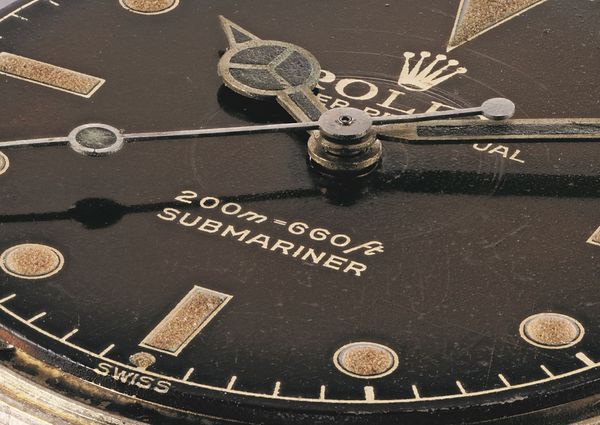
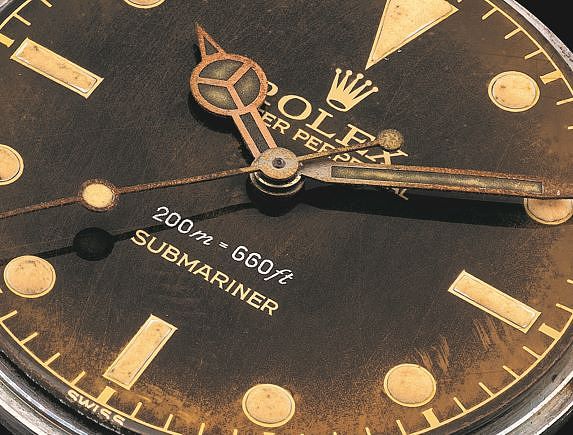
From 1964 on, new regulations mandated changes in luminous material, and the Swiss only indication was replaced by the standard “ SWISS T<25” tritium designation at the 6 o’clock.
Examples 11 and 12 - Rolex, Ref. 5512 sold during the GWA9 (Lot 218) and STLYED (Lot 66)
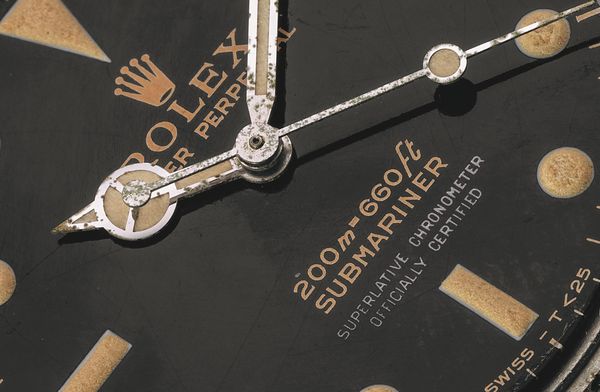

By 1967, each of these Rolex sports models transitioned to using durable, non-glossy matte dials, thereby marking the end of Rolex’s fascinating and important vintage gilt/gloss dial era.
The collecting gene for watches may be complex. But after seeing one of these dials “in the metal”, the passion and love for gilt/gloss is easy to comprehend.
Credit and thanks to Andrew Hantel (@t_swiss_t) and John Field (@beaumont_miller_ii) for their tremendous scholarship which I used as references for the above.
